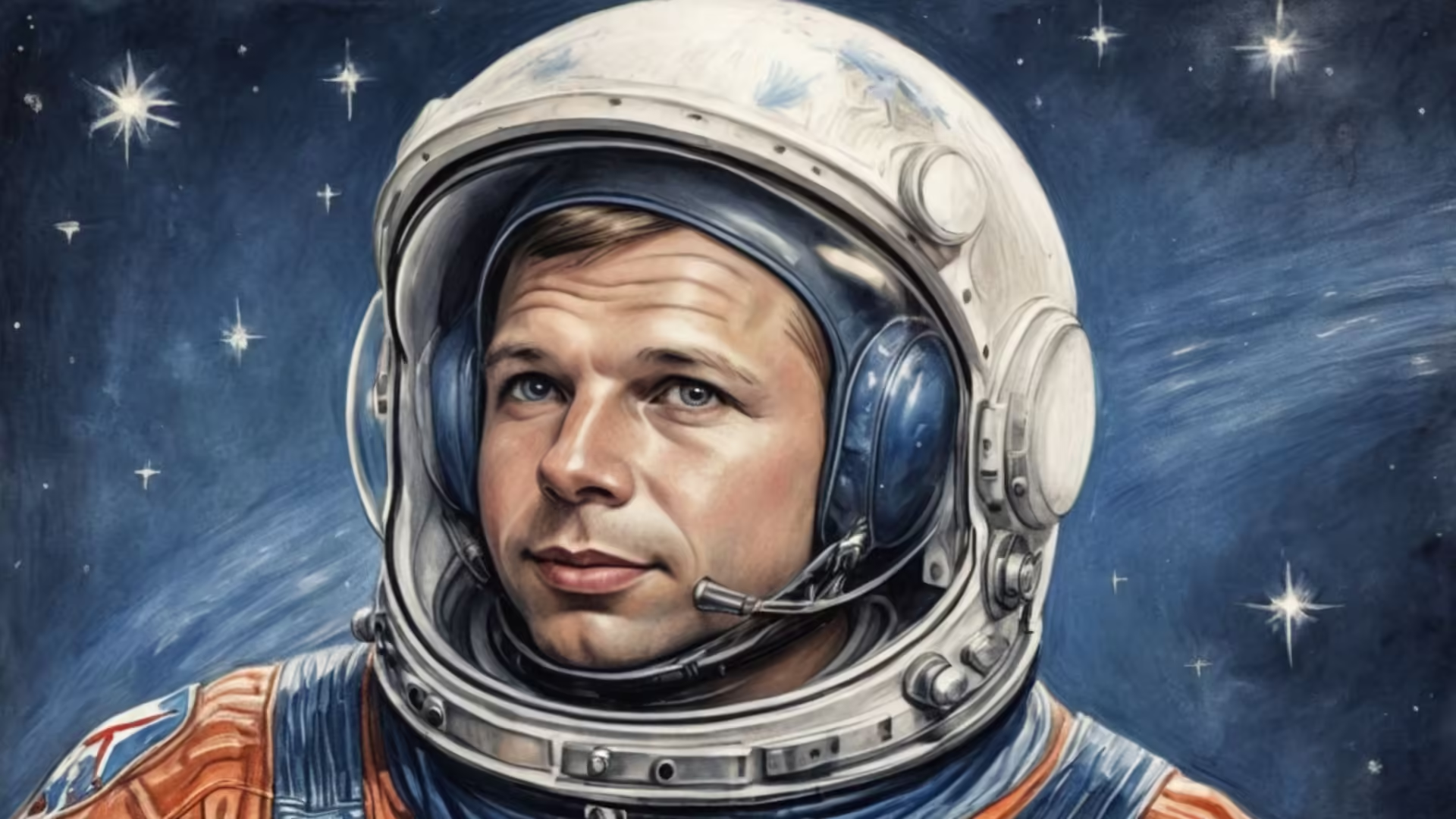The Gist
Early Life: Humble Beginnings of a Future Hero
Yuri Alekseyevich Gagarin was born on March 9, 1934, in a small village called Klushino, Russia, to a working-class family. Growing up in the challenging years of World War II, Gagarin’s early life was filled with hardships. His family was displaced during the German occupation, and they endured many struggles just to survive. However, Gagarin’s curiosity and resilience shone through from a young age. He had a keen interest in mechanics and science, which led him to pursue studies in technical fields.
After high school, Gagarin attended a technical school, where his fascination with flight deepened. This passion ultimately led him to the Soviet Air Force, where he trained to become a fighter pilot. His performance as a pilot caught the attention of the Soviet space program, which was seeking candidates for its ambitious mission to send the first human into space. Gagarin’s skill, along with his unbreakable spirit, made him an ideal candidate for this historic journey.
Becoming the First Human in Space
The space race between the United States and the Soviet Union was in full swing by the late 1950s. Both countries aimed to demonstrate their technological prowess by being the first to send a human into space. The Soviet Union was determined to take the lead, and in 1961, they selected Gagarin for this mission.
On April 12, 1961, at just 27 years old, Yuri Gagarin made history. Strapped into the Vostok 1 spacecraft, Gagarin launched from the Baikonur Cosmodrome, rocketing into orbit around the Earth. As he ascended, he reportedly exclaimed, “Poyekhali!”—a phrase roughly meaning “Let’s go!” His enthusiasm reflected the excitement of this unprecedented moment in human history. During his 108-minute flight, Gagarin orbited the Earth once, traveling at an incredible speed of 27,400 kilometers per hour (about 17,000 miles per hour).
Gagarin’s journey wasn’t without its risks. The technology was new, and there were many unknowns about how space would affect the human body. However, he remained calm, focused, and optimistic throughout the mission. As he looked down at Earth from the Vostok’s small porthole, he became the first human to see our planet from the vastness of space. His flight proved that humans could survive and function in space, paving the way for future explorations.
The Global Impact of Gagarin’s Flight
Yuri Gagarin’s successful flight made headlines around the world, and he became an international hero overnight. The impact of his journey went beyond national pride for the Soviet Union; it was a global achievement that inspired people across the world. Gagarin was celebrated in numerous countries, receiving medals, awards, and honors wherever he went. His warm smile, approachable nature, and humility made him a beloved figure worldwide, bridging cultural and political divides.
Gagarin’s flight represented a major victory for the Soviet Union in the space race, showcasing its technological advancements and signaling the beginning of a new era in human exploration. The phrase “first man in space” became synonymous with his name, and he was hailed as a symbol of human courage and potential. For many, Gagarin’s achievement was a reminder that humanity’s curiosity and determination could lead us to overcome even the greatest challenges.
Life After Space: Ambassador for Science and Exploration
After his flight, Yuri Gagarin continued to work with the Soviet space program, although he was never sent on another mission. The Soviet Union, eager to protect their national hero, assigned him to roles that minimized risk, such as training new cosmonauts and serving as an ambassador for space exploration. Gagarin also completed his studies at the Zhukovsky Air Force Engineering Academy, strengthening his scientific and technical expertise.
In this new role, Gagarin traveled the world, promoting space exploration and advocating for peace. He visited numerous countries, speaking about his experiences and the importance of scientific progress. His charisma and genuine passion for his work endeared him to audiences everywhere. Gagarin’s legacy was not just that of a cosmonaut but of a symbol for hope and unity. His journey from a small village to the stars was an inspiring story for people around the globe, encouraging young minds to dream big and pursue careers in science and technology.
Tragic End and Lasting Legacy
Tragically, Yuri Gagarin’s life was cut short on March 27, 1968, when he died in a training flight crash near Moscow. He was only 34 years old. The news of his death shocked the world, and his passing was deeply mourned. Gagarin was buried with full honors in Moscow, and he remains a celebrated figure in Russia and around the world.
Despite his early death, Gagarin’s legacy lives on. He is remembered each year on April 12, known as Yuri’s Night or the International Day of Human Space Flight. This day celebrates human space exploration and the spirit of discovery that Gagarin embodied. Monuments, schools, and streets around the world are named in his honor, and his story continues to inspire generations of scientists, explorers, and space enthusiasts.
The Enduring Inspiration of Yuri Gagarin
Yuri Gagarin’s journey from humble beginnings to becoming the first human in space is a testament to the power of courage, curiosity, and determination. His flight was more than just a technological achievement; it was a defining moment that showed what humanity could accomplish when driven by curiosity and ambition. Gagarin’s story reminds us of the importance of exploring the unknown and pushing beyond our limits.
Today, Gagarin’s influence can be seen in the ongoing exploration of space, from the International Space Station to missions exploring distant planets and galaxies. As we continue to venture into space, the legacy of Yuri Gagarin serves as a reminder of the pioneering spirit that made it all possible. His life and achievements encourage us to look to the stars and imagine a future where space exploration continues to unite and inspire us.
In the end, Yuri Gagarin will always be remembered not just as the first man in space but as a symbol of human potential, inspiring us to reach for the stars and embrace the unknown.
Let’s Talk
So, Yuri Gagarin—the first human to step out into space and look back at Earth. Isn’t it amazing to think that just one person’s journey could change how we see ourselves as a species? Before Gagarin’s flight, space was this untouchable mystery. Sure, there were theories, telescopes, and dreams of rockets, but no one had actually been out there. Gagarin’s journey was like taking the first leap into the ocean and discovering there’s a whole world beneath the surface.
Can you imagine what he must have felt, looking down at Earth from space? Here’s this kid from a small Russian village, suddenly up in the vastness of space, seeing our planet from a view no human had ever experienced. I mean, talk about perspective. Seeing Earth as this fragile blue dot, no borders, no divisions, just one whole, must have been incredibly humbling. It makes me wonder—how would we see our own lives, our problems, or even each other, if we all had that view just once?
And let’s think about that iconic phrase he shouted: “Poyekhali!” or “Let’s go!” It’s so casual and full of excitement, almost like he’s going on a joyride. It’s a reminder that even in a moment as intense as blasting off into space, he kept a sense of wonder and enthusiasm. How many times do we face the unknown in our own lives but hesitate, too nervous to jump in? Gagarin’s words feel like a nudge to just go for it. I wonder, what would our “let’s go” moments be? Maybe a new job, moving to a new place, or even just trying something out of our comfort zone. Sometimes, all it takes is that spark of curiosity to make a leap.
After his journey, Gagarin became a symbol of humanity’s potential, inspiring people from all walks of life. He didn’t just belong to Russia; he belonged to everyone, like he became this ambassador for the whole human race. That’s what exploration does—it doesn’t just expand borders; it shrinks them. And now, with people from around the world working on projects like the International Space Station, it feels like Gagarin’s vision lives on. His flight showed us that space is for all of us, and that’s something pretty special.
So, here’s a question: what do you think is the modern-day equivalent of Gagarin’s journey? Is it Mars exploration? Maybe it’s the tech pushing the boundaries of artificial intelligence. Or perhaps it’s something else entirely, like understanding the depths of our oceans or tackling climate change. Where do you think humanity’s next big “let’s go” moment lies?
Let’s Learn Vocabulary in Context
Let’s take a look at some of the vocabulary that popped up while talking about Yuri Gagarin and his journey into space. These words aren’t just tied to space travel; they’re words we can use in everyday life to describe exploration, adventure, and pushing limits.
First up is cosmonaut. A cosmonaut is a Russian astronaut. While we don’t use this word in daily conversation, it’s fun to think of how we can use “astronaut” or “cosmonaut” metaphorically. You might say, “He’s a real astronaut in the kitchen,” to mean someone who experiments fearlessly with new recipes!
Next, we have launch. To launch means to start something big or to send something off with force. Gagarin’s launch into space was a literal lift-off, but in everyday life, we “launch” ideas, projects, and even careers. You could say, “I’m ready to launch my new business this summer!”
Orbit is another word that originally describes the path an object takes around a planet. But orbit is often used in a social sense, too—like when someone is constantly around something or someone, they’re “in their orbit.” For instance, “He’s always in her orbit, hoping for some advice.”
Then we have pioneer. A pioneer is someone who explores uncharted territories or tries something completely new. Gagarin was a space pioneer, but you might call someone a pioneer if they’re the first in their field or they’re introducing a new way of thinking. Think of “She’s a pioneer in sustainable fashion.”
Curiosity is that eagerness to know or learn something. Gagarin’s curiosity about space pushed him to explore the unknown. In our own lives, curiosity keeps us interested and motivated, like “My curiosity about photography led me to start a new hobby.”
Perspective is how you view something. Gagarin’s perspective changed when he saw Earth from space—a view that gave him a new outlook on humanity. You might say, “Traveling gave me a new perspective on life,” to describe how seeing new places changed how you view things.
Legacy refers to something lasting or passed down from one generation to another. Gagarin left a legacy of exploration and discovery. In everyday terms, you might say, “My grandmother’s recipes are her legacy to our family.”
Mission is a task or purpose, often with a sense of importance. Gagarin’s mission was to orbit Earth, but in life, we all have our own missions, whether personal or professional. You might say, “My mission this year is to improve my health and well-being.”
Endurance is the ability to withstand hardship or stress over time. Gagarin showed endurance in training and during his spaceflight. You could use it in daily life as in, “Running a marathon takes a lot of endurance, both physical and mental.”
Finally, there’s ambassador. While an ambassador is usually a person representing a country, it’s also used for people who represent a certain idea or organization. You might say, “She’s an ambassador for mental health awareness,” if she promotes or speaks up for mental health topics.
Here are a couple of questions to think about: What’s a “mission” in your life that you feel strongly about? And if you could be an ambassador for any cause, what would you choose?










0 Comments